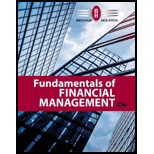
Fundamentals of Financial Management (MindTap Course List)
15th Edition
ISBN: 9781337395250
Author: Eugene F. Brigham, Joel F. Houston
Publisher: Cengage Learning
expand_more
expand_more
format_list_bulleted
Question
Chapter 16, Problem 6Q
Summary Introduction
To explain: The maturity matching approach and its difference from aggressive or conservative approach and the effect of this approach on profits and on risk and, the approach which is most suitable.
Introduction:
Current Assets:
Any asset, which can be reported in the form of cash within the duration of 1 financial year is classified as current assets.
Expert Solution & Answer
Trending nowThis is a popular solution!

Students have asked these similar questions
Article: Current Bank Problem Statement
The general problem to be surveyed is that leaders lack an understanding of how to address job demands, resulting in an increase in voluntary termination, counterproductive workplace outcomes, and a loss of customers.
Bank leaders discovered from customer surveys that customers are closing accounts because their rates are not competitive with area credit unions.
Job demands such as a heavy workload interfered with employee performance, leading to decreased job performance.
Healthcare employees who felt the organization’s benefits were not competitive were more likely to quit without notice, resulting in retention issues for the organization.
Information technology leaders who provide job resources to offset job demand have seen an increase in (a) new accounts, (b) employee productivity, (c) positive workplace culture, and (d) employee retention.
The specific problem to be addressed is that IT technology leaders in the information technology…
How to rewrite the problem statement, correcting the identified errors of the Business Problem Information and the current Bank Problem Statement (for the discussion: Evaluating a Problem Statement)
Don't used hand raiting and don't used Ai solution
Chapter 16 Solutions
Fundamentals of Financial Management (MindTap Course List)
Ch. 16 - What are some pros and cons of holding high levels...Ch. 16 - Prob. 2QCh. 16 - What are the two definitions of cash, and why do...Ch. 16 - Prob. 4QCh. 16 - What are the four key factors in a firm's credit...Ch. 16 - Prob. 6QCh. 16 - Why is some trade credit called free while other...Ch. 16 - Define each of the following loan terms, and...Ch. 16 - Why are accruals called spontaneous sources of...Ch. 16 - Indicate using a (+), (), or (0) whether each of...
Ch. 16 - CASH CONVERSION CYCLE Parramore Corp has 12...Ch. 16 - RECEIVABLES INVESTMENT Leyton Lumber Company has...Ch. 16 - COST OF TRADE CREDIT AND BANK LOAN Lancaster...Ch. 16 - Prob. 4PCh. 16 - RECEIVABLES INVESTMENT McEwan Industries sells on...Ch. 16 - WORKING CAPITAL INVESTMENT Pasha Corporation...Ch. 16 - Prob. 7PCh. 16 - CURRENT ASSETS INVESTMENT POLICY Rentz Corporation...Ch. 16 - Prob. 9P
Knowledge Booster
Similar questions
- 3 years ago, you invested $9,200. In 3 years, you expect to have $14,167. If you expect to earn the same annual return after 3 years from today as the annual return implied from the past and expected values given in the problem, then in how many years from today do you expect to have $28,798?arrow_forwardPlease Don't use Ai solutionarrow_forwardEnds Feb 2 Discuss and explain in detail the "Purpose of Financial Analysis" as well as the two main way we use Financial Ratios to do this.arrow_forward
- Nikes annual balance sheet and income statement for 2022-2023 and 2024arrow_forwardWhat is the value at the end of year 3 of a perpetual stream of $70,000 semi-annual payments that begins at the end of year 7? The APR is 12% compounded quarterly.arrow_forwardFirm A must pay $258,000 to firm B in 10 years. The discount rate is 16.44 percent per year. What is the present value of the cash flow associated with this arrangement for firm A? -I got the answer of 56331.87773=56332 (rounded to the nearest dollar), but it says incorrect.arrow_forward
arrow_back_ios
SEE MORE QUESTIONS
arrow_forward_ios
Recommended textbooks for you
 EBK CONTEMPORARY FINANCIAL MANAGEMENTFinanceISBN:9781337514835Author:MOYERPublisher:CENGAGE LEARNING - CONSIGNMENT
EBK CONTEMPORARY FINANCIAL MANAGEMENTFinanceISBN:9781337514835Author:MOYERPublisher:CENGAGE LEARNING - CONSIGNMENT Financial Reporting, Financial Statement Analysis...FinanceISBN:9781285190907Author:James M. Wahlen, Stephen P. Baginski, Mark BradshawPublisher:Cengage Learning
Financial Reporting, Financial Statement Analysis...FinanceISBN:9781285190907Author:James M. Wahlen, Stephen P. Baginski, Mark BradshawPublisher:Cengage Learning Survey of Accounting (Accounting I)AccountingISBN:9781305961883Author:Carl WarrenPublisher:Cengage Learning
Survey of Accounting (Accounting I)AccountingISBN:9781305961883Author:Carl WarrenPublisher:Cengage Learning Managerial AccountingAccountingISBN:9781337912020Author:Carl Warren, Ph.d. Cma William B. TaylerPublisher:South-Western College Pub
Managerial AccountingAccountingISBN:9781337912020Author:Carl Warren, Ph.d. Cma William B. TaylerPublisher:South-Western College Pub Auditing: A Risk Based-Approach (MindTap Course L...AccountingISBN:9781337619455Author:Karla M Johnstone, Audrey A. Gramling, Larry E. RittenbergPublisher:Cengage Learning
Auditing: A Risk Based-Approach (MindTap Course L...AccountingISBN:9781337619455Author:Karla M Johnstone, Audrey A. Gramling, Larry E. RittenbergPublisher:Cengage Learning

EBK CONTEMPORARY FINANCIAL MANAGEMENT
Finance
ISBN:9781337514835
Author:MOYER
Publisher:CENGAGE LEARNING - CONSIGNMENT

Financial Reporting, Financial Statement Analysis...
Finance
ISBN:9781285190907
Author:James M. Wahlen, Stephen P. Baginski, Mark Bradshaw
Publisher:Cengage Learning


Survey of Accounting (Accounting I)
Accounting
ISBN:9781305961883
Author:Carl Warren
Publisher:Cengage Learning

Managerial Accounting
Accounting
ISBN:9781337912020
Author:Carl Warren, Ph.d. Cma William B. Tayler
Publisher:South-Western College Pub

Auditing: A Risk Based-Approach (MindTap Course L...
Accounting
ISBN:9781337619455
Author:Karla M Johnstone, Audrey A. Gramling, Larry E. Rittenberg
Publisher:Cengage Learning